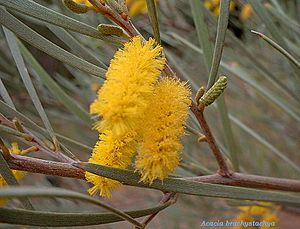Umbrella mulga facts for kids
Quick facts for kids Umbrella mulga |
|
|---|---|
 |
|
| Scientific classification | |
| Genus: |
Acacia
|
| Species: |
brachystachya
|
 |
|
| Occurrence data from AVH | |
| Synonyms | |
|
Acacia cibaria F.Muell. |
|
Acacia brachystachya, pronounced 'brackeeSTAKEeea', is a type of shrub. It is commonly known as umbrella mulga, turpentine mulga, or false bowgada. This plant belongs to the Fabaceae family. You can find it in dry areas of Australia. It grows in all mainland states except Victoria. It often lives in mulga and heath habitats. It prefers sandy hills and rocky ridges.
Contents
What Does the Umbrella Mulga Look Like?
The Acacia brachystachya is a tall, bushy shrub. It can grow up to five metres high. It has twisted, spreading stems that branch out from its base.
Like most Acacia plants, it has special "leaves" called phyllodes. These are not true leaves. They can be up to 18 centimetres long. They are usually one to three millimetres wide. Their color is a grey-green.
The flowers of the umbrella mulga are yellow. They grow in cylinder-shaped clusters. These clusters are about two centimetres long. The seed pods are long and straight. They can be up to 12 centimetres long and 8 millimetres wide. The flower stalks are up to 10mm long. They have short, stiff hairs.
Where Does the Umbrella Mulga Grow?
The Acacia brachystachya is a shrub or small tree. It is found in inland parts of Australia. You can see it in New South Wales, the Northern Territory, Queensland, South Australia, and Western Australia.
In New South Wales, it often grows in the Central Western Slopes. It is also found in the Western Plains and North Far Western Plains. This plant commonly grows in sandy loam soils. It is often found near other mulga trees. It also grows in sandy soils between sand dunes. In the eastern part of its range, it can grow on shallow, stony soils.
The umbrella mulga needs similar conditions to Acacia ramulosa. However, it grows in a smaller area. Acacia brachystachya is related to and sometimes confused with Acacia aneura and Acacia ramulosa. You can tell them apart by looking at their seed pods.
Naming the Umbrella Mulga
The Acacia brachystachya belongs to the plant family Fabaceae. It is part of the Mimosoideae group. The name Acacia brachystachya was given in 1864. It was named by George Bentham. He was an English botanist. He never visited Australia. However, he wrote an important book called Flora Australiensis. Bentham is known as one of the greatest plant scientists. He helped a lot with Australian botany.
The first sample of this plant was collected during the Bourke and Wills expedition. It was found in the Mutanie Ranges. This sample helped scientists identify the species.
The plant's name, brachystachya, comes from two Greek words. "Brachys" means "short". "Stachys" means "spike". This refers to its short flower spikes. Acacia brachystachya is in a group of Acacias called "Group 1". These plants have phyllodes. They are also the only group with flowers in cylindrical heads.
How Does the Umbrella Mulga Reproduce?
Acacia brachystachya is part of a group of plants called mulgas. Scientists have studied most Acacias well. However, many mulga plants have not been studied as much. It is thought that mulga plants are pollinated by insects. This is common for Acacias that grow in dry areas.
The umbrella mulga usually flowers from April to August. But it can flower at other times too. This depends on the weather and climate. Its flowers have both male and female parts. They can grow after heavy rainfall at any time of year.
Even if flowers appear, reproduction does not always happen. Mature pods usually only grow if flowering happens after summer rain. Then, more rain is needed in the following winter. It can be hard to identify A. brachystachya correctly. This is because it is easiest to tell it apart from similar species by looking at its pods.

